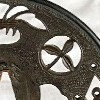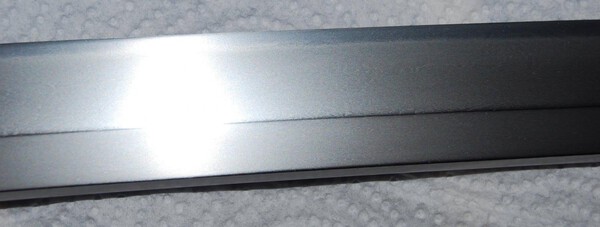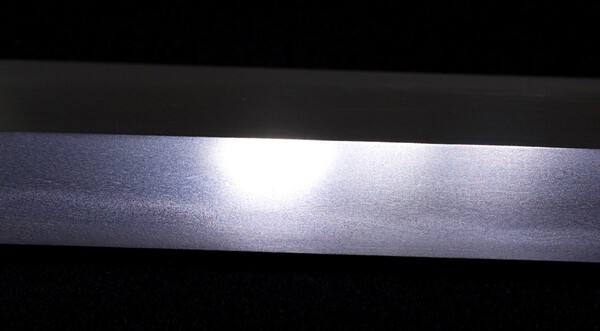-
Posts
3,154 -
Joined
-
Last visited
-
Days Won
26
Content Type
Profiles
Forums
Events
Store
Downloads
Gallery
Everything posted by Marius
-
Steven, Understood. Spot on, I could not agree more.
-
@Steven What details and refinement do you mean? And in resepct of which 17th c. tsuba schools?
-
@Jose Patina looks fine. What you find odd seem to be remnants of black lacquer or some other coating. Also, seppa dai in Higo tsuba have a totally different shape.
-
Since you have determined it is old, I bow to your superior wisdom and judgment (OK, I am being a troll here). Now have it confirmed by shinsa, and I will take back my slander
-
Oh, keep in mind that Fujishiro's system is contextual: https://yuhindo.com/ratings.html Where would I be without people like Darcy?
-
Some Takada school works are underrated. The school worked in so many styles, perhaps that is the reason, lack of "purity". I have seen a Tadayuki blade with wonderful blue steel, utsuri and what have you. A work, that - as a Japanese connoisseur has said - could pass for Rai (I will add: were the signature removed and the sword made to look like o-suriage). Another example of an underrated maker: Sakakura Seki Masayoshi, which could pass for Shizu. http://www.ksky.ne.jp/~sumie99/sword5.html I wonder how many o-suriage swords are not what the papers say? That said, they are excellent swords.
-
Come on Chris, that is a kidergarden argument, no? And it reminds me somewhat of those people who come here, ask for an opinion and take offence if the answer is not to their liking. I know, you are not such a case, but your or my liking or not has nothing to do with that topic. I know, you have proudly shown your acquisition and here comes the pooh-pooh gang ripping your tsuba apart. I sympathise, but let us stay on topic, which - to my understanding - is whether this is an old tsuba or not.
-
It is a real, although low quality tsuba. Looks late (19th c.) Nothing wrong with that, at $80 School or maker? Sorry, this could have been made everywhere. If you need to categorise - "kinko" (soft metal tsuba). Good start. But buy some books before you continue. Otherwise you'll end up with loads of cheap tsuba that you won't be able to sell.
-
Mauro, Good examples, thank you! The Kanayama in your picture is actually pretty restrained - except for one section where the tekkotsu are very pronounced (I would liken this to an imperfection in a piece of pottery, reflecting the "tea taste" typical for Kanayama) the guard is rather quiet. Those pronounced tekkotsu provide a focal point, while in Chris' tsuba a very dramatic hammer work is visible all over the plate, giving it a somewhat unbalanced look ("overdone", if you will). I know, such a description is as "helpful" as the usual write-up BS The Myochin tsuba - yes, it is papered as genuine, but it does look like a revival piece, trying to give us too much tekkotsu as if to ensure us that it reflects the aesthetics of a Kanayama tsuba. I think it would be nice to submit Chris' tsuba to shinsa, but even their verdict would be an opinion, albeit an educated one, and of course one decisive in terms of market value.
-
@Chris, As for being wrong - this happens to all of us. I don't say I am right here. I just gave some points to discuss and I gave you my opinion, which may well be nonsense. In Sasano's Tosogu no Kigen there are a few early sukashi tsuba. Look at # 33, 34 and 37 (Kamakura and Nambokucho/early Muromachi yo-sukashi). You can also analyse #31 and 32 (kage-sukashi) . All of these guard are utterly different from yours. In my humble opinion your tsuba is a failed attempt to look like an early Owari. But that is my opinion and I am not shinsa.
-
OK, to keep some balance here. I am in the camp of doubters. 1. Collection provenance says only that the item came from a particular collection. Many a collection had duds (I can think e.g. of an awful Yamakichibei fake in Rosin's collection) 2. There has been a revival period in Japanese tosogu (and swords). Many a "Yamakichibei" has beed more or less well faked. Many were great pieces (like the ones made by the Futagoyama) but combined just too many features of several generations of Yamakichibei masters. This applies to other Owari/Kanayama tsuba. 3. Your tsuba looks like if someone said "let's go for wabi here" and then went full Monty. It is overdone, with no restraint - this is very unlike old tsuba. Please compare it with Owari examples from Sasano. There is a huge difference. 4. Seppa dai is odd. To sum up - I believe this is a "revival" piece, made in the late Edo period, or even a younger piece. It does not strike me as particularly well done, although it is not quite amateurish.
-
Fred has got three for sale, the two small ones are charming: https://www.nihonto.com/category/for-sale/tsuba/
-
Grev, You are right. Such items must have a connection to the person. Not necessarily expensive. If someone loves his Yaguu tsuba... OK. They can be very good, although - very unfortunately - the appellation "Yagyu" alone makes such a tsuba expensive, even if it is mediocre or worse. Just my utterly unnecessary musings.
-
That is the joy of starting with fittings and then diving deeper and deeper into Japanese history, art and culture. To answer your question - yes, pine trees are a common motif. Look up Hasegawa Tohaku Shōrin-zu byōbu (a masterpiece). As for tsuba, here are a few examples from Aoi Art: https://www.aoijapan.com/daisho-tsuba-mumeiunsigned-matsu-tree/ https://www.aoijapan.com/tsuba-mumei-pine-tree/ https://www.aoijapan.com/kozukaogawa-yoshitunekao-pine-tree/ https://www.aoijapan.com/tsuba-mumei-aizu-shoami-raptor-on-the-pine-tree/ https://www.aoijapan.com/tsuba-mumei-unsigned-pine-tree-and-the-moon/ https://www.aoijapan.com/kozuka-mumeiunsigned-pine-tree-and-crane/
-
Chris, Thanks for the information. It would be nice if Darcy could join the discussion. He will have forgotten more Rai blades than I have seen
-
Sources? Highly interesting and contrarian post. But it lacks sources.
-
Luis, Can you explain what you mean here? A hamon is visible even under very exaggerated hadori if you point the blade towards a light source - something that you know, of course. BTW, I cannot see hamon in your pics, which is not to say it is not there.
-
The seller is a member here. Look for Krystian.
-
Frank, nice catch. I would rather say it is made of yamagane. I like those lacquer remnants. Then again, I a a sucker for old soft metal kodogu (especially if they still have lacquer)
-
Even with those data it is still a lottery.
-

Looking For Verification And Buyers Advice On 3 Swords
Marius replied to fr0stblade's topic in Nihonto
Start with a few websites: http://www.ksky.ne.jp/~sumie99/information.html Loads of knowledge from a Japanese sword smith and sword connoisseur Hirsohi Kojima (4th Naohiro) http://www.sho-shin.com Not easy to navigate, but a good resource on the 8 roads (a system much older than the gokaden) and sword schools. Search our forum for anything that you want to research - great posts here and also some good articles: http://www.militaria.co.za/nmb/forum/17-articles/ As for books, let me start with a great shop run by Grey Doffin, our long time member and one of the nicest and most helpful guys around http://www.japaneseswordbooksandtsuba.com Grey will get you any book, even if he hasn't it in stock. I will restrict my short list to sword books: Facts & Fundamentals of Japanese Swords by Nobuo Nakahara Take the statements with a grain of salt. Nakahara is a contrarian, which makes for a fun reading but some of his statements seem unfounded. As a resource when studying swords in hand: The Connoisseur's Book of Japanese Swords by Kokan Nagayama Get Markus Sesko's books on Lulu.com: https://www.lulu.com/shop/search.ep?keyWords=Markus+sesko&type= You cannot live without his Index and I recommend his Koto-kantei Zenshu and Shinto & Shinshinto-kantei Zenshu. Excellent to study great swords. Two large positions for serious studying of traditions and schools: Yamanaka Newsletters ( the reformatted version): http://www.japaneseswordbooksandtsuba.com/store/books/b550-nihonto-newsletter-yamanaka Nihonto Koza translated by Harry Afu Watson's (Grey will find you a set, I am sure) That should be enough for a while Others here will have more excellent recommendations, I am sure Have fun! -

Looking For Verification And Buyers Advice On 3 Swords
Marius replied to fr0stblade's topic in Nihonto
Stephan, Ken's advice is worth gold Welkom bij de forum! Je kunt hier altijd waardevolle informatie krijgen, maar je moet het ook gebruiken kunnen -
Welcome to the NMB Chris Here is an article about sashikomi and hadori (kesho) polish: http://www.ksky.ne.jp/~sumie99/togi.html and: http://www.ksky.ne.jp/~sumie99/togistyles.html BTW, Kojima san's site is a treasure trove and you should read all articles in the "Information" section: http://www.ksky.ne.jp/~sumie99/ Attached is a photo of a sword in sashikomi. Please note that the shinogi ji has not been burnished (it is a very good sword, BTW, a Takada Tadayuki with excellent blueish steel and utsuri - sorry about the quality of the photo) Below is another example of sashikomi polish.





